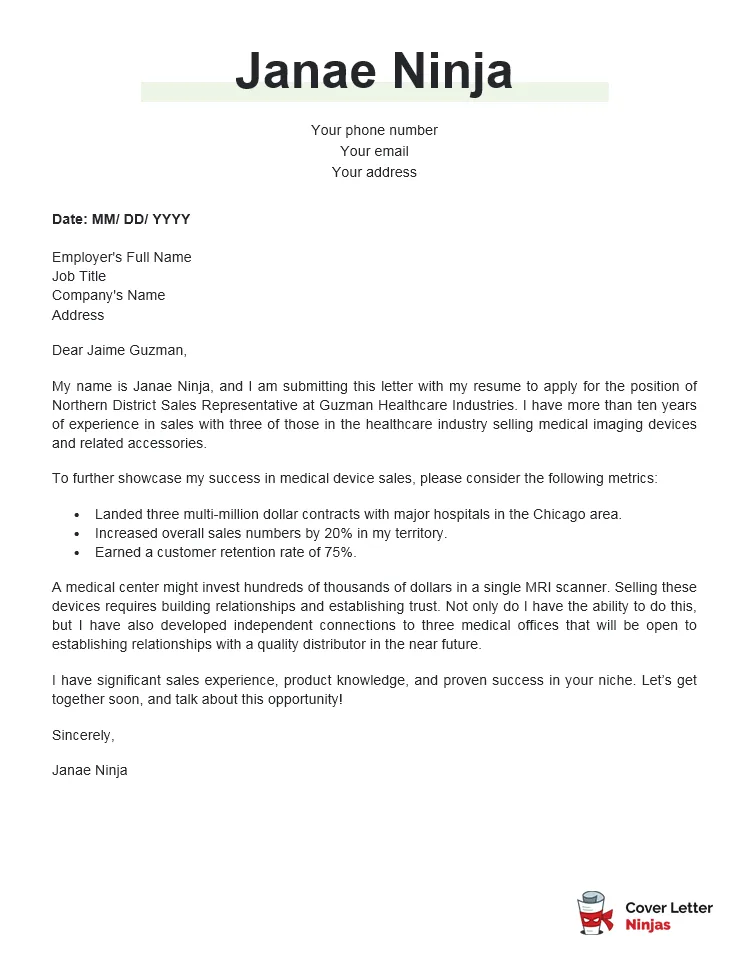Why a Medical Sales Cover Letter Matters
In the competitive world of medical sales, a compelling cover letter is your first opportunity to make a lasting impression. It serves as a crucial introduction to potential employers, providing a glimpse into your qualifications, skills, and personality. Unlike a resume, which simply lists your experiences and accomplishments, a cover letter allows you to tell your story, explain your motivations, and demonstrate why you’re the perfect fit for the role. It’s your chance to showcase your enthusiasm for the position and the company, setting you apart from other applicants. Without a well-crafted cover letter, your resume might be overlooked, as it fails to provide context or highlight your unique selling points. This document offers the chance to demonstrate your communication skills, attention to detail, and genuine interest in the specific opportunity.
Highlighting Your Achievements
When crafting your medical sales cover letter, focus on showcasing your most significant achievements. Instead of just listing responsibilities, highlight the outcomes you’ve achieved in previous roles. This could include exceeding sales targets, building strong relationships with key clients, or successfully launching new products. Quantify your accomplishments whenever possible; for example, mention the percentage by which you increased sales or the number of new accounts you acquired. Use action verbs to describe your contributions and provide specific examples to illustrate your skills and abilities. This approach demonstrates your value to potential employers and provides tangible evidence of your capabilities. Showing what you have done is always better than saying what you can do.
Quantify Your Success
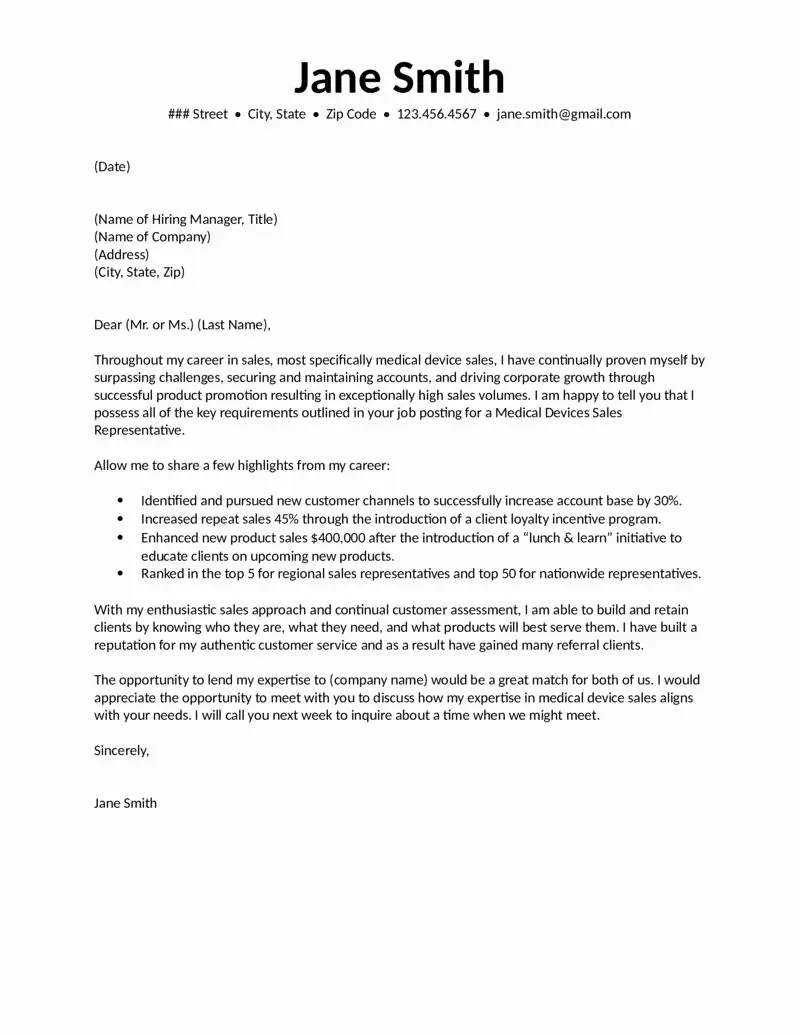
One of the most impactful ways to impress potential employers is to quantify your successes. Instead of stating you increased sales, specify the percentage by which you exceeded your sales targets. If you improved client retention rates, provide the exact percentage increase. Did you successfully launch a new product? Mention the number of units sold or the revenue generated within a specific timeframe. Quantifiable results provide concrete evidence of your abilities and demonstrate your effectiveness in previous roles. Numbers speak volumes, and they leave a lasting impression on hiring managers, making it easier for them to assess your value and potential contributions. This approach gives the impression that you pay attention to detail and you’re focused on results. Use this strategy, and you will see good results.
Tailoring Your Letter to the Role
Generic cover letters often fail to capture the attention of hiring managers. To make a strong impression, tailor your cover letter to each specific job application. Carefully review the job description and identify the key skills and qualifications the employer is seeking. Then, use your cover letter to highlight how your experience and abilities align with those requirements. Provide specific examples from your past roles that demonstrate your relevant skills, such as your ability to build relationships with healthcare professionals or your expertise in a particular therapeutic area. This personalized approach shows that you’ve taken the time to understand the role and are genuinely interested in the opportunity. This also shows you pay attention to details and you’re good at communication. Demonstrate your capabilities using this method.
Researching the Company
Before you start writing your cover letter, conduct thorough research on the company to which you are applying. Visit their website, read about their products or services, and learn about their mission and values. Understanding the company’s culture and goals will help you tailor your letter to their specific needs and demonstrate your genuine interest. Mention specific projects, products, or initiatives that resonate with you, and explain how your skills and experience can contribute to their success. Referencing recent news or events related to the company can also show that you’re up-to-date and engaged. By demonstrating your knowledge of the company, you can set yourself apart from other candidates who may have sent generic applications.
Showcasing Your Medical Sales Skills
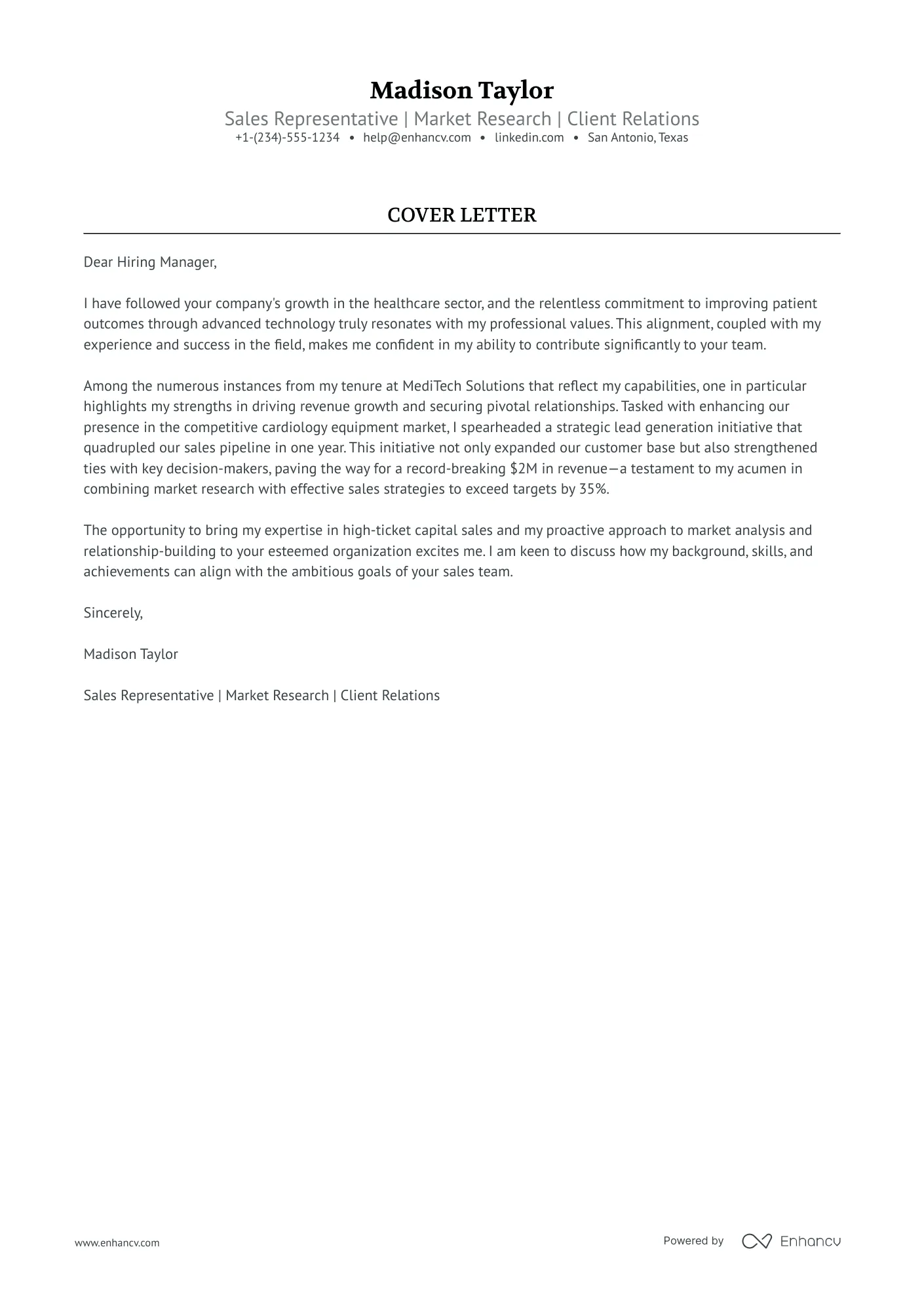
Your medical sales cover letter should prominently showcase your key skills. Highlight your ability to build relationships with healthcare professionals, your persuasive communication skills, and your expertise in sales techniques. Emphasize your understanding of the sales cycle and your track record of successfully closing deals. Mention your experience in territory management, market analysis, and product presentations. If you have experience with specific medical devices, pharmaceuticals, or therapeutic areas, be sure to mention it. Tailor the skills you highlight to match the requirements of the job description. Use strong action verbs to describe your accomplishments and provide concrete examples of how you’ve used your skills to achieve results in the past. Showing how you implement your knowledge will set you apart.
Understanding the Industry
Demonstrate your understanding of the medical sales industry. Highlight your knowledge of current trends, challenges, and regulations in the healthcare sector. Show that you are aware of the competitive landscape and can position yourself as a valuable asset. Mention any relevant certifications, training, or industry events you’ve attended. Demonstrate your awareness of the importance of compliance and ethical practices. Show your knowledge of the specific therapeutic areas relevant to the role. Employers seek candidates who are knowledgeable and adaptable, so showcasing your industry awareness can significantly boost your chances of success. Providing knowledge about the medical sales industry can easily give you an edge over your competitors.
Emphasizing Your Knowledge
Besides showcasing your skills, emphasize your knowledge of the products, services, and therapeutic areas relevant to the role. Highlight any specialized training, certifications, or experience you have that aligns with the company’s offerings. If you have a strong understanding of specific medical devices, pharmaceuticals, or treatment protocols, be sure to mention it. Demonstrate your ability to quickly learn new information and stay current with industry developments. Tailor your letter to show the hiring manager that you possess the relevant expertise to succeed in the position. Don’t just state what you know, prove it by referencing the experiences you have. By showcasing your knowledge, you’ll demonstrate that you’re not only skilled but also prepared to contribute meaningfully from day one.
Formatting Your Cover Letter for Success
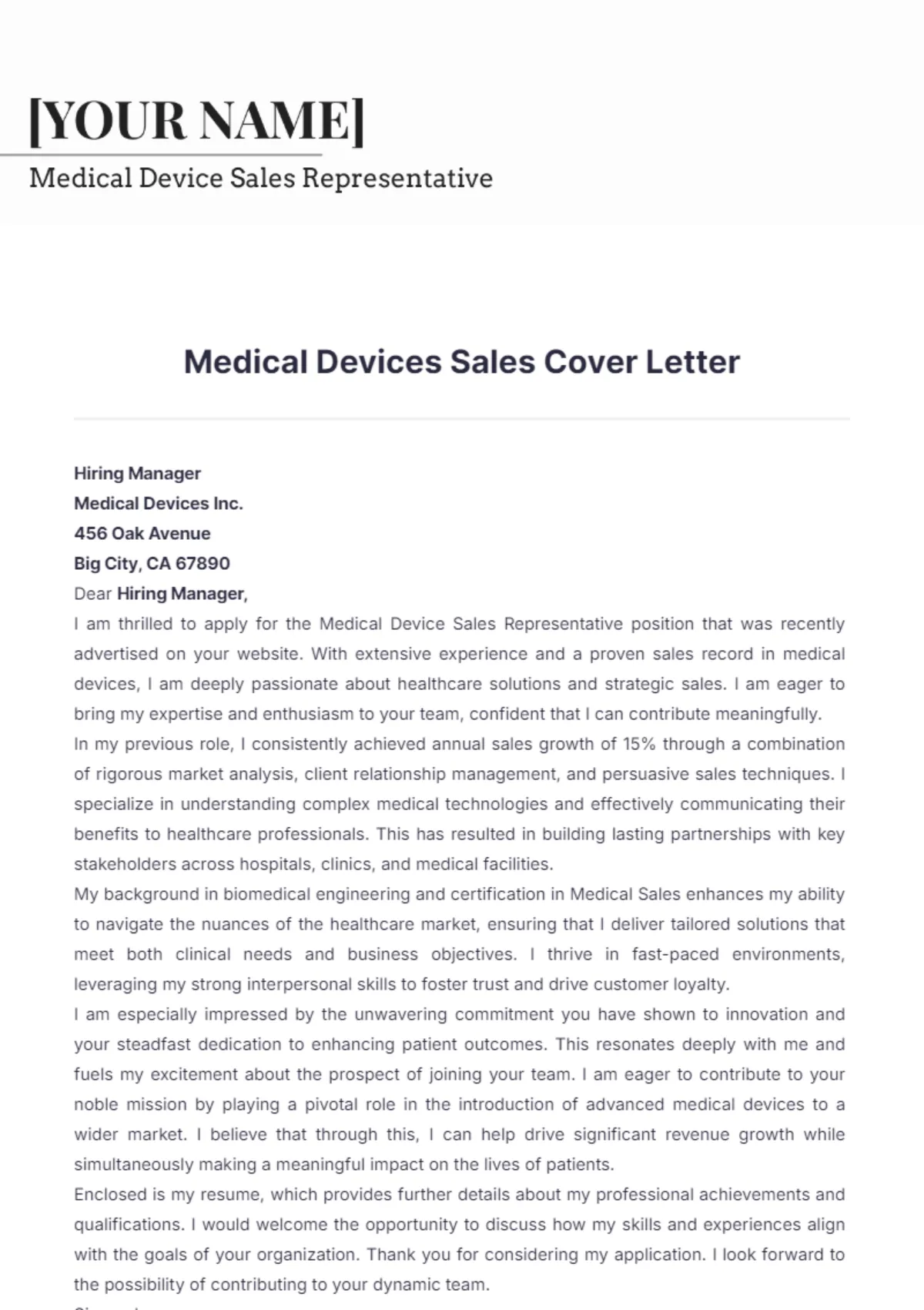
The format of your medical sales cover letter plays a significant role in its effectiveness. A well-formatted letter is easy to read and demonstrates professionalism. Use a clean, professional font such as Arial or Times New Roman, with a font size between 10 and 12 points. Maintain consistent spacing and use clear headings and bullet points to break up large blocks of text. Ensure your letter is free of grammatical errors and typos; proofread it carefully before sending it. Maintain a professional layout that is easy to follow and visually appealing. A well-formatted cover letter shows attention to detail and respect for the hiring manager’s time.
Choosing the Right Font and Layout
The font and layout of your medical sales cover letter contribute to its overall readability and professionalism. Stick to a standard, easy-to-read font like Arial, Times New Roman, or Calibri. Choose a font size between 10 and 12 points. Ensure proper spacing between paragraphs and sections to create visual breaks and make the letter more inviting to read. Use clear, concise language and avoid overly lengthy sentences or paragraphs. The layout should be balanced and uncluttered, with adequate margins on all sides. Using a professional layout ensures that your cover letter presents the best image and gives the hiring manager an easy and enjoyable reading experience. The easier it is to read, the better chance you have of getting the role.
What to Include in the Letter
A compelling medical sales cover letter typically includes several key elements. Start with a professional greeting, such as “Dear [Hiring Manager name]” or “Dear Hiring Team.” In the introduction, briefly state the position you’re applying for and how you learned about it. In the body paragraphs, highlight your relevant skills and achievements, providing specific examples to support your claims. Tailor these examples to the requirements outlined in the job description. Demonstrate your understanding of the company and the industry. Express your enthusiasm for the role and the opportunity to contribute to the organization’s success. Finally, include a call to action, such as expressing your availability for an interview. Close with a professional closing and your signature.
Professional Greeting and Introduction
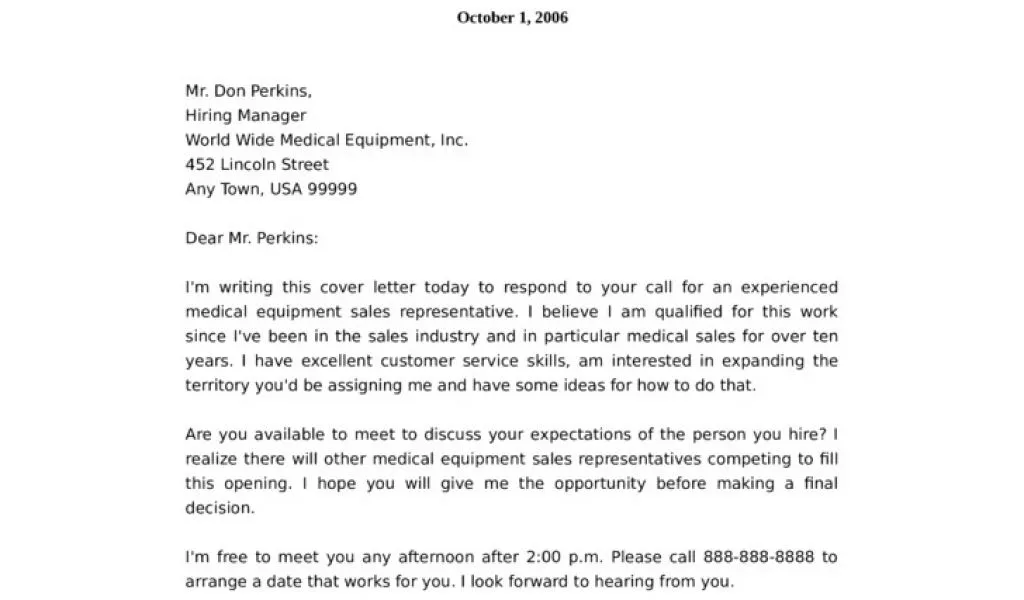
Your cover letter should start with a professional greeting. If you know the name of the hiring manager, address the letter directly to them; this personal touch can make a positive impression. If the name is not available, use a general greeting like “Dear Hiring Manager.” In the introduction, clearly state the position you’re applying for and where you found the job posting. Briefly introduce yourself and express your interest in the role. Make it clear that you are a good match for the position by highlighting your relevant experience. This first section sets the tone for the rest of your letter and helps you capture the reader’s attention immediately.
Body Paragraphs
The body of your medical sales cover letter should expand on your skills, experience, and achievements. Each paragraph should focus on a specific aspect of your qualifications and provide concrete examples to illustrate your abilities. Use the STAR method (Situation, Task, Action, Result) to structure your examples, providing context, outlining the challenges you faced, describing the actions you took, and quantifying the results you achieved. Tailor each example to align with the requirements of the job description, emphasizing the skills and experience most relevant to the role. Show how your past successes have prepared you to excel in the position you’re applying for. This is your best chance to impress the hiring manager with your accomplishments.
Call to Action
Conclude your cover letter with a clear call to action. Express your enthusiasm for the opportunity and your desire to learn more about the role. Reiterate your interest in the company and your belief that you would be a valuable asset to the team. Indicate your availability for an interview and provide your contact information. Thank the hiring manager for their time and consideration. End with a professional closing, such as “Sincerely” or “Best regards,” followed by your name. A strong call to action encourages the hiring manager to take the next step and increases your chances of moving forward in the application process.
Proofreading and Editing Your Cover Letter

Before sending your cover letter, proofread and edit it carefully. Check for grammatical errors, typos, and inconsistencies in formatting. Ensure that your letter is clear, concise, and easy to read. Pay close attention to your tone and style, making sure they are appropriate for a professional setting. Consider asking a friend or colleague to review your letter for a fresh perspective and to catch any errors you may have missed. A polished cover letter demonstrates attention to detail and professionalism, increasing your chances of making a positive impression and getting noticed by potential employers. Reviewing your work is always a good idea.
